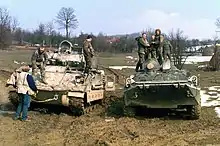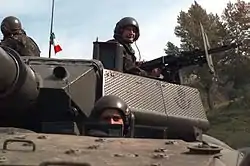Implementation Force
The Implementation Force (IFOR) was a NATO-led multinational peace enforcement force in Bosnia and Herzegovina under a one-year mandate from 20 December 1995 to 20 December 1996 under the codename Operation Joint Endeavour.
| Implementation Force | |
|---|---|
 Pocket badge of the IFOR | |
| Active | 1995–1996 |
| Country | 32 countries |
| Type | Command |
| Part of | |
| Nickname(s) | "IFOR" |
Background

NATO was responsible to the United Nations (UN) for carrying out the Dayton Peace Accords. The Dayton Peace Accords were started on 22 November 1995 by the presidents of Bosnia, Croatia, and Serbia, on behalf of Serbia and the Bosnian Serb Republic. The actual signing happened in Paris on 14 December 1995. The peace accords contained a General Framework Agreement and eleven supporting annexes with maps. The accords had three major goals: ending of hostilities, authorization of military and civilian program going into effect, and the establishment of a central Bosnian government while excluding individuals that serve sentences or under indictment by the International War Crimes Tribunals from taking part in the running of the government. IFOR's specific role was to implement the military Annexes of The General Framework Agreement for Peace (GFAP) in Bosnia and Herzegovina.[1]
IFOR relieved the UN peacekeeping force UNPROFOR, which had originally arrived in 1992, and the transfer of authority was discussed in Security Council Resolution 1031. Almost 60,000 NATO soldiers in addition to forces from non-NATO nations were deployed to Bosnia. Operation Decisive Endeavor (SACEUR OPLAN 40105), beginning 6 December 1995, was a subcomponent of Joint Endeavor.[2] IFOR began operations on 20 December 1995.[3]
The Dayton Agreement resulted from a long series of events. Notably, the failures of EU-led peace plans, the August 1995 Croat Operation Storm and expelling 200,000 Serb civilians, the Bosnian Serb war crimes, in particular the Srebrenica massacre, and the seizure of UNPROFOR peace-keepers as human shields against NATO's Operation Deliberate Force.[4]
Admiral Leighton W. Smith Jr., Commander in Chief Allied Forces Southern Europe (CINCSOUTH), served as the first Joint Force Commander for the operation, also known as Commander IFOR (COMIFOR). He commanded the operation from IFOR's deployment on 20 December 1995 from headquarters in Zagreb, and later from March 1996 from the Residency in Sarajevo.[5] Admiral Thomas J. Lopez commanded the operation from 31 July to 7 November 1996, followed by General William W. Crouch until 20 December 1996.[3] Lt Gen Michael Walker, Commander Allied Rapid Reaction Corps (ARRC), acted as Land Component Commander for the operation, commanding from HQ ARRC (Forward) based initially in Kiseljak, and from late January 1996 from HQ ARRC (Main) in Ilidža. This was NATO's first ever out-of-area land deployment. The Land Component's part of the operation was known as Operation Firm Endeavour.[6]
At its height, IFOR involved troops from 32 countries and numbered some 54,000 soldiers in-country (BiH) and around 80,000 involved soldiers in total (with support and reserve troops stationed in Croatia, Hungary, Germany, and Italy and also on ships in the Adriatic Sea). In the initial phases of the operation, much of the initial composition of IFOR consisted of units which had been part of UNPROFOR but remained in place and simply replaced their United Nations insignia with IFOR insignia.
Components

NATO member states that contributed forces included Belgium, Canada, Denmark, France, Germany, Italy, Luxembourg, the Netherlands, Norway, Portugal, Spain, Turkey, the United States, and the United Kingdom. Non-NATO nations that contributed forces included; Australia, Austria, Bangladesh, the Czech Republic, Egypt, Estonia, Finland, Hungary, Latvia, Lithuania, Malaysia, New Zealand, Pakistan, Poland, Romania, Slovakia, Sweden, Russia, and Ukraine.[7]
The tasks of the Land Component were carried out by three Multi National Divisions:[8]
- Multi-National Division (South-East), Mostar – French led. Also known as the 'Division Salamandre.'[9][10] The divisional headquarters was provided by 6th Light Armored Division then 7th Armoured Division.
- French Brigade Alpha,[11] Jablanica
- 2nd Foreign Parachute Regiment[12]
- Moroccan Battalion[13] - Igman
- French Brigade Bravo, Sarajevo
- 6th Marine Infantry Parachute Regiment[14]
- 21st Marine Infantry Regiment[15]
- Ukrainian Battalion[16]
- Italian Garibaldi Brigade, Sarajevo
- 8th Bersaglieri Regiment[17]
- Portuguese Battalion
- Egyptian Battalion
- 42nd Spanish Mountain Brigade,[18] Medjugorje - Col Julio López-Guarch Muro
- French Brigade Alpha,[11] Jablanica
- Multi-National Division (South-West), Banja Luka – British led. The British codename for their armed forces' involvement in IFOR was Operation Resolute.[21] Division headquarters was provided by 3 (UK) Division[22] then 1st (UK) Armoured Division.[23]
- 4th UK Armoured Brigade, Šipovo - Brig Richard Dannatt
- 2nd Bn, The Light Infantry[24]
- 1st Bn, Royal Regiment of Fusiliers[25]
- Dutch Battalion[26] - Šišava
- Malaysian Battalion - Livno
- 2nd Canadian Mechanized Brigade, Ćoralići - Brig Gen Bruce Jeffries
- Canadian Battalion
- Queen's Royal Hussars[27] - Mrkonjić Grad
- Czech Battalion[28] - Ljubija
- 4th UK Armoured Brigade, Šipovo - Brig Richard Dannatt
- Multi-National Division (North), Camp Eagle at Tuzla – US led. Task Force Eagle. The US Army 1st Armored Division under the command of Major General William L. Nash, constituted the bulk of the ground forces for Task Force Eagle. They began to deploy on 18 December 1995 and would return to Germany in late 1996.
- 1st Brigade, 1st Armored Division,[29] Camp Kime - Col Gregory Fontenot.
- 1st Sqdn, 1st Cavalry - Camp Gentry
- 3rd Bn, 5th Cavalry - Camp McGovern
- 4th Bn, 67th Armor - Camp Stephens
- 2nd Brigade, 1st Armored Division,[30] Camp Lisa - Col John Batiste
- 3rd Sqdn, 4th Cavalry - Camp Molly, Camp Alicia
- 4th Bn, 12th infantry - Camp Demi, Camp Pat
- 2nd Bn, 68th Armor - Camp Linda
- 1st Russian Independent Airborne Brigade,[31] Camp Ugljevik - Col Alexander Ivanovich Lentsov[32]
- Nordic-Polish Brigade,[33]Doboj - Danish Brigadegeneral Finn Særmark-Thomsen
- Danish Battalion[34] (Estonia, Latvia and Lithuania each provided a platoon size element to reinforced the battalion) - Camp Dannevirke, Camp Valhalla
- Swedish Battalion - Camp Oden
- Polish Battalion - Teslić, Žepče
- Finnish Engineer Battalion - Camp Jussissa
- Norwegian Logistics Battalion - Modrica
- Turkish Brigade,[35] Zenica - Col Ahmet Berberoglu
- Turkish Battalion
- Romanian Engineer Battalion[36]
- 1st Brigade, 1st Armored Division,[29] Camp Kime - Col Gregory Fontenot.
On 20 December 1996, the task of IFOR was taken over by SFOR.[37] In turn, SFOR was replaced by the European EUFOR Althea force in 2004.[38]
NATO began to create service medals once it began to support peacekeeping in the former Yugoslavia, which led to the award to IFOR troops of the NATO Medal.[39]
Gallery

 An American M2 Bradley and a Russian BTR-80 during a patrol near Zvornik
An American M2 Bradley and a Russian BTR-80 during a patrol near Zvornik A Swedish soldier manning a civilian checkpoint leading to the Joint Civilian Commission meeting in Doboj
A Swedish soldier manning a civilian checkpoint leading to the Joint Civilian Commission meeting in Doboj A Danish Leopard 1 preparing to drive over and crush a Serbian Zastava M55 anti-air gun
A Danish Leopard 1 preparing to drive over and crush a Serbian Zastava M55 anti-air gun The crew of an Italian B1 Centauro deployed as part of IFOR
The crew of an Italian B1 Centauro deployed as part of IFOR
 A British convoy passing through Kupres
A British convoy passing through Kupres Greek soldiers guarding a truck carrying polling equipment for the 1996 Bosnian general election in Zenica
Greek soldiers guarding a truck carrying polling equipment for the 1996 Bosnian general election in Zenica
See also
Notes
- The General Framework Agreement for Peace (GFAP) in Bosnia and Herzegovina
- "Appendix C: References", Federation of American Scientists Archived 26 September 2008 at the Wayback Machine
- "Peace support operations in Bosnia and Herzegovina". NATO. Retrieved 18 December 2020.
- "NATO AIRCRAFT ATTACK BOSNIAN-SERB TANK" (Press release). NATO. 22 September 1994.
- SFOR leaves Residency Compound
- Operational Analysis Support to NATO IFOR/SFOR Operations
- Clark, A.L. (1996). Bosnia: What Every American Should Know. New York: Berkley Books.
- https://www.armyupress.army.mil/portals/7/combat-studies-institute/csi-books/mcgrath_boots.pdf
- The Multinational Division South-East in Bosnia Archived 28 June 2013 at the Wayback Machine
- https://publicaciones.defensa.gob.es/media/downloadable/files/links/r/e/revista_ejercito_672.pdf
- http://cavaliers.blindes.free.fr/rgtactive/recap6-opex.html#batinf6
- https://foreignlegion.info/history/2rep/
- https://farmorocco.wordpress.com/royal-moroccan-army/history/moroccan-military-history-independence-and-restoration/
- http://cavaliers.blindes.free.fr/rgtactive/recap6-opex.html#batinf2
- http://cavaliers.blindes.free.fr/rgtactive/recap6-opex.html#batinf4
- https://publicaciones.defensa.gob.es/media/downloadable/files/links/r/e/revista_ejercito_675.pdf
- https://www.esercito.difesa.it/en/organization/The-Chief-of-General-Staff-of-the-Army/Southern-Operational-Forces-Command/Garibaldi-Bersaglieri-Brigade/8th-Bersaglieri-Regiment/Pagine/The-medal-collection.aspx
- https://ejercito.defensa.gob.es/en/misiones/europa/bosnia/09_SPABRI_I.html
- https://ejercito.defensa.gob.es/unidades/Huesca/rczm_galicia64/Historial/index.html
- https://ejercito.defensa.gob.es/unidades/Zaragoza/rclac11/Unidades/index.html
- "British Forces Bosnia". Parliamentary Debates (Hansard). 18 July 1996. Retrieved 13 April 2013.
- "Army senior appointments". United Kingdom Government News. 23 July 2002. Archived from the original on 26 July 2011. Retrieved 13 April 2013.
- Lord, p. 304
- https://www.youtube.com/watch?v=STzHLNWgNL4
- https://www.youtube.com/watch?v=sjUqlPSsi4k
- https://english.defensie.nl/topics/historical-missions/mission-overview/1995/implementation-force-ifor-stabilization-force-sfor-and-european-force-eufor/dutch-contribution
- https://www.canada.ca/content/dam/themes/defence/caf/militaryhistory/dhh/honours/commonwealth-foreign-honours.pdf
- https://www.army.cz/assets/en/ministry-of-defence/newsroom/publication/20-let-acr_en.pdf
- https://www.armyupress.army.mil/Portals/7/military-review/Archives/English/MilitaryReview_20070831_art007.pdf
- https://ufdcimages.uflib.ufl.edu/AA/00/06/21/90/00011/03-15-1996.pdf
- https://collections.unu.edu/eserv/UNU:2429/ebrary9280810790.pdf
- An account of the interactions of the Americans and Russians in Bosnia in 1996 may be found in James Nelson, Bosnia Journal: An American Civilian's Account of His Service With the 1st Armored Division and the Russian brigade in Bosnia.
- https://apps.dtic.mil/sti/pdfs/ADA389550.pdf
- https://icds.ee/wp-content/uploads/2018/05/RKK_Apprenticeship__Partnership__Membership_WWW.pdf
- https://ufdcimages.uflib.ufl.edu/AA/00/06/21/90/00016/04-19-1996.pdf
- https://ispaim.mapn.ro/webroot/fileslib/upload/files/Occasional%20Papers/OP%2016%202011.pdf
- "History of the NATO-led Stabilisation Force (SFOR) in Bosnia and Herzegovina". NATO. Retrieved December 18, 2018.
- Hawton, Nick (October 23, 2004). "EU troops prepare for Bosnia swap". BBC News. Retrieved December 18, 2018.
- "NATO Medal for Former Yugoslavia (NATO-FY)". National Defence and the Canadian Armed Forces. July 22, 2015. Retrieved December 18, 2018.
Further reading
- Charles Bertin, A Summer in Mostar: 50 days with the Salamander Division, January – June 1996
- Lord, Cliff (2004). Royal Corps of Signals: Unit Histories of the Corps (1920–2001) and its Antecedents. Helion & Company. ISBN 978-1-874622-92-5.
- Phillips, R. Cody. Bosnia-Herzegovina: The U.S. Army's Role in Peace Enforcement Operations 1995–2004. Washington, D.C.: United States Army Center of Military History. CMH Pub 70-97-1. Archived from the original on 9 December 2013.
- Siegel, Pascale (1998). Target Bosnia (PDF). Archived from the original (PDF) on 28 June 2015. Retrieved 19 January 2007.
- Wentz, Larry (1998). Lessons from Bosnia: The IFOR Experience (PDF).
- Lambert, Nicholas (2002). Measuring the Success of the North Atlantic Treaty Organisation (NATO) Operation in Bosnia and Herzegovina 1995 – 2000. Issue 140/2, pp. 459–481. European Journal of Operations Research, Special 2000 Edition. doi:10.1016/S0377-2217(02)00083-8.
External links
![]() Media related to IFOR at Wikimedia Commons
Media related to IFOR at Wikimedia Commons
- CCRP Bosnia Research and Publications
- Information on Operation Joint Endeavour on the NATO Website